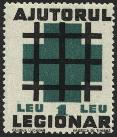
Back الحرس الحديدي (رومانيا) Arabic Lexón de San Miguel Arcánxel AST Dəmir Qvardiya Azerbaijani Жалезная гвардыя Byelorussian Желязна гвардия Bulgarian Guàrdia de Ferro Catalan Železná garda Czech Jerngarden Danish Eiserne Garde German Σιδηρά Φρουρά Greek
| Légion de l'Archange Michel Legiunea Arhanghelului Mihail | ||||||||
 Logotype officiel. | ||||||||
| Présentation | ||||||||
|---|---|---|---|---|---|---|---|---|
| Leader | Corneliu Codreanu (1927-1938) Horia Sima (1938-1941) |
|||||||
| Fondation | [1] | |||||||
| Scission de | Ligue de défense national-chrétienne | |||||||
| Disparition | 23 janvier 1941 (interdit) | |||||||
| Siège | 4 rue Gutenberg, Maison verte, Bucarest |
|||||||
| Président | Gheorghe Cantacuzino-Grănicerul (en) (1935-1937) Gheorghe Clime (en) (1937-1938) |
|||||||
| Fondateurs | Corneliu Codreanu Radu Mironovici (ro) Ion Moța (en) Corneliu Georgescu (ro) Ilie Gârneață (en)[4] |
|||||||
| Organisation de jeunesse | Confrérie de la Croix | |||||||
| Organisation prolétarienne | Corpul Muncitoresc Legionar (en) | |||||||
| Organisation paramilitaire | Garde de fer (en) (1930–1941)[5] | |||||||
| Religion | Église orthodoxe roumaine | |||||||
| Positionnement | Extrême droite | |||||||
| Idéologie | Légionarisme | |||||||
| Affiliation internationale | Congrès international fasciste de Montreux | |||||||
| Adhérents | 272 000 (estimation fin 1937)[19] | |||||||
| Couleurs | Vert, noir et blanc | |||||||
| ||||||||
| Représentation | ||||||||
| Députés (1937 (en)) | 66 / 387 |
|||||||
| Sénateurs (1937 (en)) | 4 / 113 |
|||||||
| modifier |
||||||||


La Garde de fer (en roumain : Garda de Fier) est un mouvement et un parti nationaliste révolutionnaire et fasciste qui exista dans le royaume de Roumanie entre 1927 et le début de la Seconde Guerre mondiale.
- Ioanid, Radu (2006). The sacralised politics of the Romanian Iron Guard
- Picture of the Green House
- Julius Evola, Arktos, 2015, A Traditionalist Confronts Fascism, p. 71
- Horia Sima, The history of the Legionary Movement, Legionary Press, , 144 p. (ISBN 1-899627-01-4, OCLC 272381280, lire en ligne).
- « Iron Guard | Romanian organization ».
- Stephen J. Lee, European Dictatorships, 1918–1945, Routledge, London, 2000, p.288. (ISBN 0-415-23046-2).
- Payne, Stanley G. (1995). A History of Fascism 1914–1945 Madison: University of Wisconsin Press (pp. 277–289) (ISBN 0-299-14874-2).
- Rebecca Haynes, « Work Camps, Commerce, and the Education of the 'New Man' in the Romanian Legionary Movement », The Historical Journal, vol. 51, no 4, , p. 943–967 (DOI 10.1017/S0018246X08007140, JSTOR 20175210, S2CID 144638496, lire en ligne).
- Volovici, Nationalist Ideology, p. 98, citing N. Crainic, Ortodoxie și etnocrație, pp. 162–4
- Final Report, p.28-29
- Subtelny, Orest. (1988) Ukraine: a History. Toronto: University of Toronto Press, pg. 442
- Volovici, Nationalist Ideology, p. 98, citing N. Cainic, Ortodoxie şi etnocraţie, pp. 162–4
- « Rădăcinile intelectuale ale legionarismului ».
- « AUR și Mișcarea Legionară. Cât de valabilă este comparația între cele două partide », .
- Ideologies and National Identities : The Case of Twentieth-Century Southeastern Europe, Central European University Press, coll. « CEUP collection », , 19–53 p. (ISBN 9786155053856, lire en ligne), « Chapter 1. Charisma, Religion, and Ideology: Romania's Interwar Legion of the Archangel Michael ».
- https://www.illiberalism.org/the-legionary-phenomenon-a-romanian-fascist-manifesto/ Modèle:Bare URL inline.
- « Mişcarea Legionară, între istorie și percepții actuale. Amestec de fascism și atitudini populiste », Polis. Journal of Political Science, vol. 3, no 37, , p. 65–80 (lire en ligne).
- Iordachi, Constantin (2023). The Fascist Faith of the Legion "Archangel Michael" in Romania, 1927–41 Martyrdom and National Purification. Routledge. (ISBN 978-1138624559).
- Săndulescu, p. 267
- Bellant, Russ (1991). Old Nazis, the New Right, and the Republican Party. Boston: South End Press. p. 75. (ISBN 0896084183).
Erreur de référence : Des balises <ref> existent pour un groupe nommé « alpha », mais aucune balise <references group="alpha"/> correspondante n’a été trouvée
